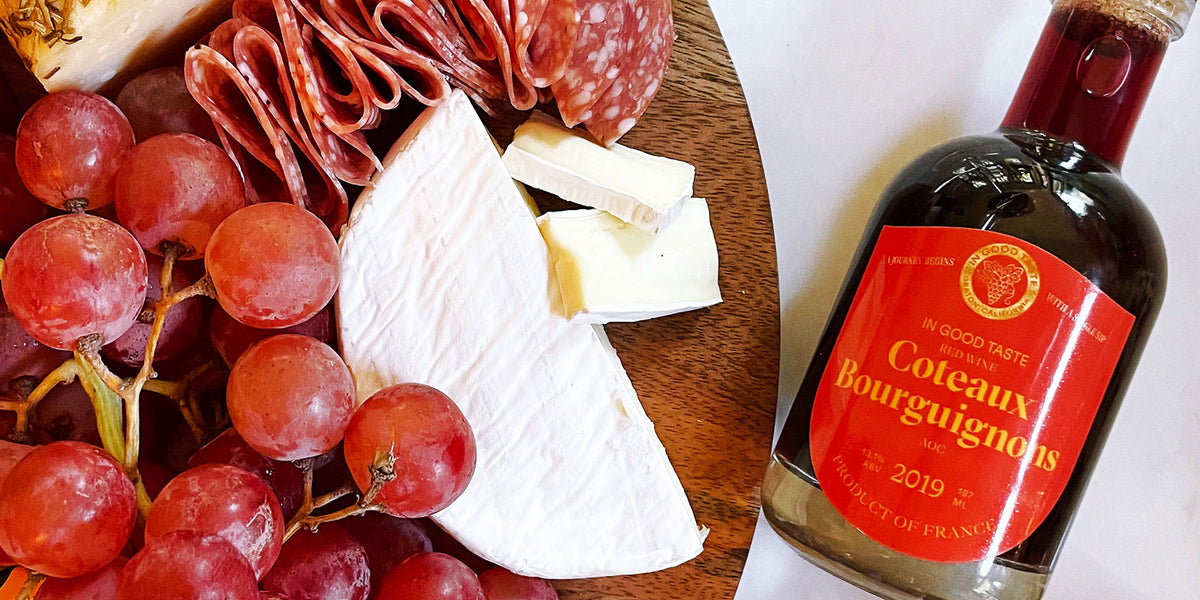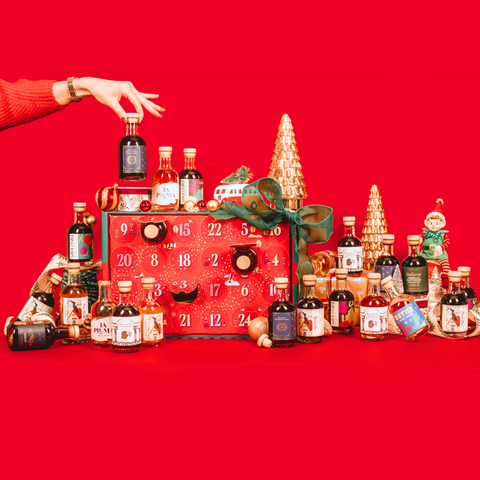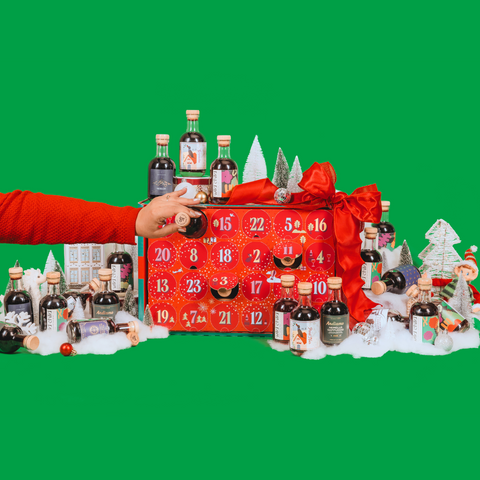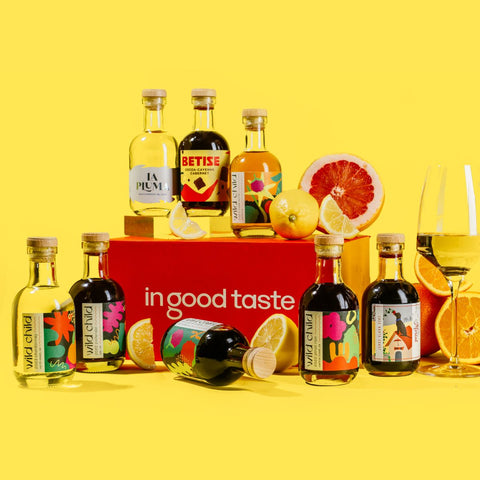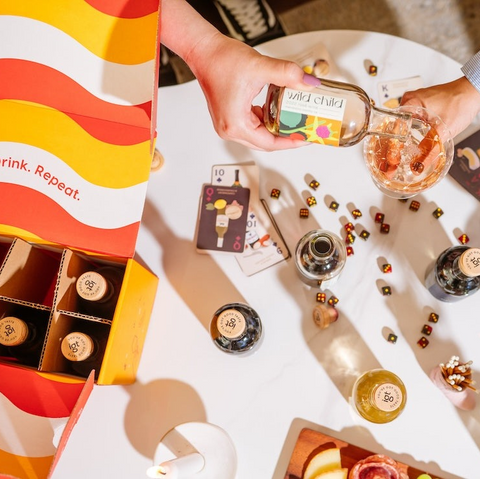Flavor, Complexity, and Mystery
Burgundies are some of the world’s finest and most loved (and sometimes most expensive!) red and white wines. These wines feature complex flavors and unique styles that directly reflect the particular region of Burgundy where they were produced. In fact, geography is one of the most important considerations when talking about Burgundies.
So, what is Burgundy exactly? Is it a place? Is it a brand? The answers to these questions are not as simple as they may seem. Generally speaking, Burgundies are red or white wines produced in the Burgundy region of central France from two types of grapes: Pinot Noir for reds and Chardonnay for whites. Simple enough. However, that's where the simplicity ends.

The Great Burgundy Confusion
Do you remember when you were first learning how to spell, and your teacher taught you the simple rhyme: “I before E except after C” ? This "rule" probably helped you learn how to spell several words correctly at the time. Since then, however, you’ve probably realized that it’s less of a rule and more of a starting point. Burgundy is like this phrase.
There is massive debate over what can be classified as Burgundy wine. But that makes sense when you consider that there is even debate over what parts of the region make up Burgundy. For example, there are technically seven wine-producing regions in Burgundy. However, Beaujolais, a region long thought to be part of Burgundy, has now started producing its distinctive styles of wines using the Gamay grape. Similarly, Châtillonnais uses Aligoté grapes to make white wines, and it doesn’t stop there.
There is a long history of infighting, betrayal, drama, politics, and jockeying for position throughout the Burgundian wine world. Hundreds of books have been written on Burgundy and its wines. Even wine experts struggle to understand Burgundy fully. This article won’t go into the weeds of these debates and controversies. Instead, we’ll do our best to cover some Burgundy basics so that you have a point of reference for understanding — and enjoying — this complex category of wine.
History of Burgundy Wine
Burgundy has a rich history of wine that has been recognized and appreciated for centuries. Winemaking in Burgundy is traceable back to the Romans in the 1st century A.D. But it was the monks of the Cistercian Order of the Catholic Church who recognized the region's ability to grow grapes that impart a unique quality that is unmatched by anywhere else in the world.

Their realization, and their subsequent planting of vineyards in the area, helped establish Burgundy as one of the premier wine-growing regions of the Old World. Thanks to their efforts, people ranging from kings and aristocrats to common folk have tasted and praised the virtues of Burgundies.
This region has also been the stage for some of French history’s darkest and most turbulent times. From the Hundred Years' War to the French Revolution to World War II, this region has witnessed pain and joy, destruction and recovery. Most recently, in the period between World War II and the 1980s, much of Burgundy fell into hard times and began to see a decline. Many of its vineyards had been abandoned or destroyed in the war, so enterprising winemakers sought to replenish the regional soil with artificial fertilizers. However, this approach soon transformed into an over-reliance on artificial fertilizers that drained much of Burgundy's rich soil of its valuable nutrients.
Sensing that they were about to lose the very thing that makes Burgundy wines special, winemakers in the area began to focus on sustainable, regenerative soil management. Since then, Burgundy's replenished soil has regained much of its former glory. Today the region remains one of the most beloved wine-producing regions in the world.
Burgundy's Geography and Climate
Why is Burgundy so special when it comes to great-tasting wines? Terroir is a term that describes a particular region's climate, soil, microbial activity, and topography that all come together to affect the taste of the wine. In the Burgundy region, the soil is primarily limestone, full of various plant and marine fossils. This fact leads experts to theorize that the region was once an ancient tropical seabed. In fact, many believe that these elements of Burgundy's soil play a major role in giving these French wines their distinctive flavors.

Regions of Burgundy
Burgundy has five primary wine regions (well, six or seven depending on what you decide to do with Beaujolais and Châtillonnais). Each region is known for its distinctive styles of Burgundy. We will look at the five non-controversial regions in this review.
Chablis
Pronounced “shah-blee,” this northernmost region in Burgundy is famous for its white wines, specifically its bold approach to Chardonnay. Unlike most Chardonnay producers, Chablis producers age their wine in stainless steel vats instead of oak barrels, which gives their wine a distinctively crisp and fresh flavor. Cooler climate Chards also have their own basic set of tastes, and are more Granny Smith apple crisp, with lemon zest
Côte de Nuits
This region's name means "the night slope," and it is primarily known for its classic Pinot Noirs, though it also produces Chardonnay and Rosé. This region is home to two dozen Grand Cru vineyards (more on what this means shortly) and features some of the world’s most coveted wine real estate. It's also where some of the most expensive French wines originate.
Côte de Beaune
This region's name means " the slope of Beaune." Beaune is a nearby town built next to a local spring that gets its name from the god of fast-flowing water. Known for its classic Chardonnay, this region represents the heart of Burgundy's wine trade.
Côte Chalonnaise
The Chalon slope does not have any Grand Cru vineyards, but it is still a popular region known for its affordable and accessible Pinot Noir. It is also home to a delightful Sparkling Crémant and several other sparkling wines.
Mâconnais
Mâcon is the home of great-value Chardonnay that displays wonderfully fresh flavors. The south-most region in Burgundy, it is the largest and warmest of the regions we’ve listed. In a way, it is also the cultural black sheep of the Burgundian family that often forges its own path when it comes to its wines.

Classification & Notable Burgundy Wines
Burgundy represents an entire constellation of wine and wine styles that are closely tied to their geography. In 1936, France codified a classification of Burgundy's wines based on where it was grown. One hundred approved wine-growing areas within Burgundy's regions were defined, and these plots were divided into four levels. The highest level represented the best land for growing the highest quality wines.
Burgundy classifications are as follows:

Grand Cru
As mentioned before, Grand Cru is the highest level of Burgundy wines. There are only 33 Grand Cru vineyards in Burgundy, 24 of which are in Côte de Nuits. If you see "Grand Cru" on the label, then you are likely looking at a bottle of one of the highest quality Burgundy wines available. If you look at the price tag, you’ll probably notice it’s one of the most expensive bottles as well.
Premier Cru
The next level down represents more than 600 premier plots throughout Burgundy. These wines vary dramatically in style and quality. Some are expensive, and others are less so. You will likely be able to find some of these wines at your local high-end grocery store.
Village Wines
The next classification covers wines from 44 villages in this region, and this category represents nearly 40% of Burgundy's total wine production. Village wines are a great bang for the buck and a wonderful intro to Burgundy wines.
Regional Wines
Lastly, there are regional wines, which make up more than half of Burgundy's remaining wine production. These are affordable wines that you can usually find on the shelves at your local grocery store.
To complicate things further, Chardonnay from Chablis has its own classification system for its white Burgundy wines:

Grand Cru Chablis
On the northern side of the town of Chablis lies a beautiful south-facing slope with seven plots on it. These plots make up the one Grand Cru Chablis. This plot produces this region's most coveted and most expensive white wines.
Premier Cru Chablis
This category refers to the plots that grow alongside the River Serein, which runs through Chablis. These are also highly coveted wines, but compared to the Grand Cru varietal, they tend to be more affordable.
Chablis
If you’ve been a white wine enthusiast for any amount of time, chances are you have encountered this term on the label of a white wine bottle. This is the most common category of wine from this region, and it is widely distributed worldwide.
Petit Chablis
This category does not necessarily imply that the wines in this classification are lower quality or even lesser than other Chablis. The diminutive name refers to the specific regions directly around the town of Chablis. The region’s soil leads to wines that deliver a crisp, fresh taste thanks to their higher acidity.
What to Expect from Burgundy Wine
Burgundies are generally balanced wines with delicate floral aromas. Red wines boast beautiful yet traditional red wine coloring and will have tasting notes of raspberries, cherries, currants, and spices. White wines range from pale yellow to gold and offer notes of peaches, apples, herbs, and citrus. Of course, the most defining tasting characteristic of each Burgundy is its terroir — the unique geography where it was grown and produced.
Minerality is a recently developed term that refers to flavors that are not quite fruit flavors, not quite herbal flavors, and not quite spice flavors. The description doesn’t imply that you’ll taste minerals (like potassium and calcium); it encompasses a category of flavors that don’t quite fit into any of the more traditional categories. Many Burgundies have notes of minerality, which is one of the top reasons they vary so widely and provide such intriguing flavor profiles.
This variety is one of the reasons why Burgundy is such an exciting wine to taste. The uniqueness from region to region and plot to plot takes your tastebuds on an exciting adventure. The category is complicated, broad, and full of controversy, but if you ask us, that challenge is what makes it so interesting!
What Wine Glasses Should I Use for Burgundy
Despite its other complexities, Burgundy simply follows the rules for other wines when it comes to which kind of wine glass to serve it in. Red wines should be served in oversized red wine glasses. White wine should be served in white wine glasses.

What’s the Best Temperature for Burgundy wine?
When serving Burgundy wines, we recommend that your reds are served no lower than 57° F. Serving them too cold can cause you to miss out on their natural fruitiness and sweetness. White wines should be served chilled, around 52° F, to complement the natural crispness.

What Should You Serve With Burgundy Wine?
Both red and white Burgundies pair well with a variety of foods. Red Burgundies pair best with savory selections like charcuterie boards, lamb, and chicken. White Burgundy complements these meats as well, but it also pairs great with seafood and fresh salads. Gouda, goat cheese, and parmesan are excellent cheese pairings for white Burgundies, and rosemary, garlic, and peppercorn are common herbs and spice pairings.
How Long To Age Burgundy Wine
The good news is that both red and white Burgundies can be enjoyed after aging for only 1-3 years. They are excellent wines with a lot of complexity and flavor nuance. However, something unique happens when Burgundies fully develop. After 12-15 years of aging, the wine’s most distinctive flavor notes reveal themselves. Once you sip these more mature wines, you begin to understand why a fully developed Burgundy is so special.
Where To Begin
So, how do you begin your adventure with Burgundy? In our opinion, the best way to tackle Burgundy is just to start exploring. You can take the first steps of your Burgundy adventure by ordering our Coteaux Bourguignons, or sample more wines from Europe in our Passport Collection.

